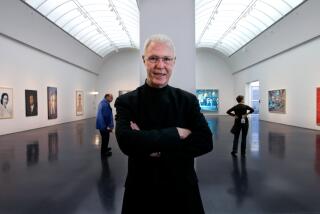Sound of Silence at O.C. Arts Center
- Share via
If you’re calling in reference to the situation at the Orange County Performing Arts Center, please reach my attorney . . .
--Tom Tomlinson’s home answering machine
*
This is not the way Mark Chapin Johnson, board chairman of the Orange County Performing Arts Center, wanted it to happen.
The abrupt departure last week of center President Tom Tomlinson--dubbed “resignation” in customary centerspeak but described as an ouster by at least one highly placed arts official--has put a dent in Johnson’s shiny image as the new Mr. Nice Guy who has said he wants to end the center’s historic reputation for secrecy.
No reason was given for Tomlinson’s exit and nobody is answering any questions. Calls aren’t being returned. Speculation as to what triggered the sudden removal of the soft-spoken 46-year-old--who was gone without so much as a goodbye--has swept a stunned arts community, where he was well liked. But as one top arts executive says, “No one knows, and nobody [who knows] is talking.”
*
Sound like a mob hit shrouded in vows of omerta? It wasn’t the only such remark. Elaine Redfield, one of the center’s founders, said: “I’ve even spoken to Tom Nielsen”--a former center chairman, now a vice chairman--”and he says he doesn’t know. At this point it’s obviously a hot potato.”
Before taking over as chairman in January, Johnson spread the word that openness and candor would be at the top of his agenda. He invited people to lunch with him privately, just to tell them that. He couldn’t have been more emphatic.
So what happened?
A few months later, in March, Tomlinson--whose three-year, $450,000 contract would expire in January 1997--was put in a broom closet marked “Strategic Planning,” in this instance, the corporate kiss of death from on high. Judith O’Dea Morr, who used to be the brains behind the center’s day-to-day programming operations before Tomlinson got here, was brought back on staff.
*
The center denied that anything was amiss with Tomlinson’s performance at the time or that his job was in jeopardy. When I visited him in his office in early April to ask him about this, he professed not to know what I was talking about. Morr, who sat on a sofa opposite him, pursed her lips and refused to say a word. She shook her head “no,” vehemently, to deny the rumors.
Speculation in the arts community, which proved true, indicated that the center’s dance programming--its chief claim to fame--had gone flat at the box office (as has dance programming at similar venues elsewhere).
Worse, the gap between the center’s earned revenues and expenditures was growing, despite a banner year for programming other than dance. So there was a greater need than ever to raise more funds.
Meanwhile, there were rumblings that the king in his court--Henry T. Segerstrom, whose land, money and power had made the center possible--no longer had confidence in Tomlinson’s leadership. Although they worked together and mixed at center functions, they reportedly were distant from each other socially and personally.
Segerstrom probably wanted “a more mature kind of leader,” one well-connected arts executive said. “More of a politician. And [Tomlinson] clearly isn’t.”
What has Johnson said about any of this?
Not enough to make good on his promise of openness and candor. When pressed to explain Tomlinson’s leave-taking, to reveal the incident that triggered it, Johnson replied: “I will not say anything other than to say that I looked into Tom’s eyes and promised him I would not discuss anything.”
*
Johnson ought to know that secrecy takes its revenge. The lack of candor emanating from the center’s inner sanctum is bound to fester and contaminate plans for the center’s future. Unless he does something to clear the air, his own leadership is called into question.
In the 1980s when Thomas R. Kendrick was president, the center had a reputation as an obsessively controlled and controlling environment, which fostered abrasive relations with the resident groups that also present events there, such as the Philharmonic Society of Orange County and the Pacific Symphony. The harm that was caused resonated up through the early ‘90s, to the point where the center’s backstage muscle-flexing spawned wide resentment within the arts community.
Now, with the secrets of the Tomlinson affair apparently being kept from the center’s own board of directors--as some board members are saying--the vow of a new openness at the county’s most prominent arts institution looks increasingly like a bad joke.
Of course, the 49-person board would have to make a concerted effort to find out what’s going on, which isn’t likely given its history of falling into line quietly.
As one former board member said the other day, “What they know is controlled by a few. If certain people on the board said the moon was made of Swiss cheese one day and Muenster the next day, the board would go along with them.”
*
It’s equally unlikely that any concerned arts activists will be out picketing the center, Johnson, Segerstrom or the rest over this shroud of secrecy.
For the three years Tomlinson was the chief operating officer of the center, he could be relied upon to keep the secrets himself. He rarely said anything revealing or noteworthy about what made the center tick.
More to Read
The biggest entertainment stories
Get our big stories about Hollywood, film, television, music, arts, culture and more right in your inbox as soon as they publish.
You may occasionally receive promotional content from the Los Angeles Times.










